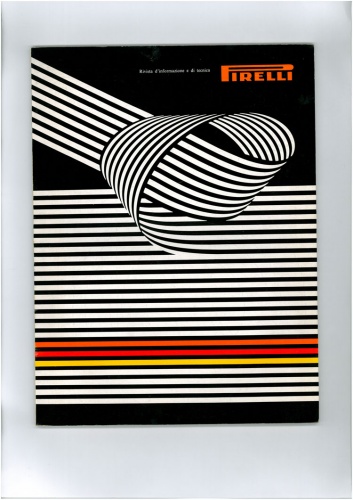The exhibition exploring Franco Grignani’s distinctive, modernist designs
As a new exhibition featuring some of Grignani’s most famous works opens at London’s Estorick Collection of Modern Italian Art, we ask curator Marco Meneguzzo why the artist and designer’s style remains so influential internationally today.

As one of the most famous Italian artists and graphic designers of the 20th century, Franco Grignani is known for his distinctive, geometric, and often monochromatic style. After studying mathematics and architecture in the late 1920s and early 1930s, he went on to open a studio in Milan specialising in exhibition design and graphics.
Now, a new exhibition at the Estorick Collection of Modern Italian Art in London is showcasing more than 100 of Grignani’s most famous paintings, along with his graphic design projects for clients including Penguin Books, automotive company Pirelli and former printer Alfieri & Lacroix.
We speak to the exhibition curator Marco Meneguzzo to find out more about the exhibition.
Design Week: Why do you think Franco Grignani was such an influential designer?
Marco Meneguezzo: Sometimes creating a single successful project is enough for an individual to become an influential designer. The International Wool Secretariat (IWS) logo is such a well-known design that Grignani’s name will never be forgotten. It remains his most significant success as a designer.
DW: Can you explain the story behind his design for the Woolmark logo?
MM: Grignani was part of a jury for an international competition to design a new logo for the IWS, which is still used today as a certification mark on wool products to indicate that they meet the organisation’s standard of quality.
However, he felt that a lot of the submissions from Italian designers were of a poor quality. Secretly, he developed his own proposal under the name Francesco Saroglia, who was an employee at an Italian graphic studio. Grignani never thought that he would win, he only wanted to demonstrate a modern Italian style. He voted against his own project for ethical reasons, despite the other members of the jury enthusing about it and saying that it looked a lot like some of the designer’s own projects. Despite his own vote, Grignani’s design – based on the shape of a skein of wool – was chosen as the overall winner.
DW: How did studying mathematics and architecture influence his creative style?
MM: The essence of Grignani’s creativity was based around the idea of the “variant”. This may have come from him studying mathematics and architecture, but I think Grignani was more like an alchemist than a mathematician. He constantly experimented with form, whether this applied to a physical object, photo, pattern, texture or drawing.
DW: What are the similarities and differences between his work across different disciplines, such as exhibition design, advertising campaigns and graphics?
MM: Grignani worked during a time when advertising was not as specialised as it is today. Back then, companies usually asked artists to produce work for campaigns and other graphic design projects. Artists – especially those skilled in balancing the art world and working world – responded to these briefs by applying their creative style to commercial projects. The textures seen in Grignani’s artworks – which have become synonymous with the designer – were turned into powerful graphic patterns by the designer. Grignani created campaigns for everyone from medical companies in the 1950s to fabric retailers in the 1960s, many of which were adapted directly from the style of his artworks. His commercial work was typical of a concept seen throughout the Neo-Avantgarde era – to distort the way people perceived reality.
DW: What are some of his other most famous works?
MM: From the 1950s he was a member of Alliance Graphique Internationale (AGI) and the International Centre of Typographic Art in New York, as well as being art director at Pubblicità in Italia – one of the most internationally-reputed magazines for graphic design. In these roles, he worked with the likes of Pirelli, Ermenegildo Zegna, Penguin Books, Dompé Pharmaceuticals, and as a result his style became famous across the world.
DW: How has he gone on to influence other designers, both in the UK and internationally?
MM: His style was unmistakable even at the time, despite the fashion for optical designs during the 1960s. Now, we are living in a period of revival for this geometric, optical style of imagery and decoration, so Grignani’s name and work is once again on the frontline.
Franco Grignani: Art as Design 1950-1990 runs until 10 September 2017 at the Estorick Collection of Modern Italian Art, 39a Canonbury Square, London N1 2AN. Entry is £6.50 for adults, and £4.50 for concessions. For more information, visit the gallery’s site.



DISSOCIAZIONE DAL BORDO (285) DETACHMENT FROM THE EDGE (285)
1969. 70 X 70 CM MIXED MEDIA ON SCHOELLER CARD AND MASONITE ARCHIVIO MANUELA GRIGNANI SIRTOLI

TENSIONI IN SIMBIOSI SYMBIOTIC TENSIONS 1964
96 X 96 CM
OIL ON CANVAS EMILIO AND VERONICA CAMPANILE

OPERATIVO NUMERICO (31/B) NUMERICAL OPERATIVE (31/B) 1965
72 X 72 CM
TEMPERA ON SCHOELLER CARD ARCHIVIO MANUELA GRIGNANI SIRTOLI

LA FRATTURA DEL RUMORE (1279) THE FRACTURING OF NOISE (1279)
1990
73 X 73 CM
TEMPERA ON SCHOELLER CARD ARCHIVIO MANUELA GRIGNANI SIRTOLI

WOOLMARK LOGO
1963
ARCHIVIO MANUELA GRIGNANI SIRTOLI

ADVERTISMENT FOR DOMPÉ FARMACEUTICI’S ‘CARDIORITMON’ MEDICINE 1956
ARCHIVIO MANUELA GRIGNANI SIRTOLI

ADVERTISMENT FOR DOMPÉ FARMACEUTICI’S ‘ARTROSIL B1’ MEDICINE
1950
ARCHIVIO MANUELA GRIGNANI SIRTOLI

WOOLMARK LOGO
1963
ARCHIVIO MANUELA GRIGNANI SIRTOLI

ADVERTISEMENT FOR PIRELLI 1967
ARCHIVIO MANUELA GRIGNANI SIRTOLI
-
Post a comment




